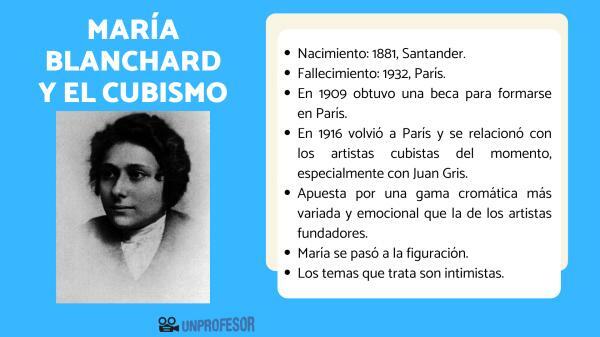Maria Blanchard and cubism

Maria Blanchard (1881-1932) is one of the great artists of spanish cubism. A figure that remained in the background despite her rich and prolific work. María, born in Santander, was the owner of a great artistic talent, a talent that she overcame her disability and makes her interest in her figure more and more today.
In this lesson from a PROFESSOR we tell you who was María Blanchard and her role in cubism. A unique artist that we invite you to meet.
One of the factors that most marked the artistic work of María Blanchard was her illness. A kyphoscoliosis that she supposed living with pain and a physical appearance that gave her a complex. However, before her affirmation that she would change all her work for a bit of beauty, writers such as Ramón Gómez de la Serna or poet Federico García Lorca made emphasize your genius. A talent that was also praised by art figures such as Diego Rivera or politicians such as Clara Campoamor.
María was a kind artist and, despite feeling bad about her appearance, she allowed herself to be portrayed on several occasions, especially by the Swedish painter
Tora Vega Holmstromshe, an artist whom she met in one of her stays in Paris, like other painters such as Juan Gris and André Lothe.But, and despite the recognition she received in her immediate circle, the figure of Blanchard was only she seriously studied after his death. Her nonconformity and rebellion caught the attention of artists such as Juan Gris, Lipchitz, Metzinger, Diego Rivera, Picabia and Picasso, maintaining a great friendship with Juan Gris and being part of the Parisian cubist group. Thus, at present, María has become a very popular painter and valued in auction houses.
Maria Blanchard she died of tuberculosis in Paris in 1932her, at the age of 51.

Cubism was the artistic movement that most caught the attention of this artist. She presents an artistic career in which the following points stand out:
- She was born into a cultured family with an interest in art.. In 1903 she began her training with painters such as Emilio Sala, Fernando Álvarez de Sotomayor and Manuel Benedito.
- In 1909 she obtained a scholarship to train in Paris with painters such as Anglada Camarasa and Kees van Dongen. Some teachers who oriented her towards the freedom of color and expression, distancing herself from Spanish academicism.
- The world war marks his return to Spain, her participation in intellectual gatherings, participation in exhibitions and work as a drawing teacher in Salamanca.
- In 1916 she returned to Paris and she related to the cubist artists of the moment, especially with John Gray, an artist who will exert a notable influence on her.
- Maria assimilated the budgets of cubism, but contributing a personal touch as, for example, with regard to color treatment.
- Cubism tries to represent a new dimension: time. In her work 'Still Life' (1918), María will try to show us all the faces of the table and all the objects. The passage of time is a movement that does not show changes in the same plan or see all the faces of the table from different angles.
- María Blanchard is committed to a more varied and emotional range of colors than that of the founding artists, such as Pablo Picasso and Georges Braque.
- The objects represented in her paintings are more recognizable, also resorting to the matter painting, that is, the use of large amounts of paint to achieve the sensation of volume and provide more drama and expressiveness.
- After cubism, María went to the figuration. A figuration with a certain constructive influence of cubism.
- Maria's style is characterized by dramatic colors and violent contrasts.
- The topics she deals with are intimate, showing underdog and expressive characters.
- Starting in the 1920s, María consolidated a different style with angular faces, geometric figures, acid and dark colors.
- Women and beauty are her main themes, especially maternity and female nudes. Some maternity hospitals that represent a mother who loves her baby, but who has difficulties raising her.
Now that you know the story of María Blanchard and cubism better, we recommend you read these other lessons on the types of cubism and the Cubism artists - The most important.



